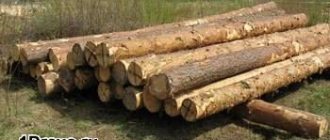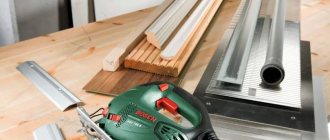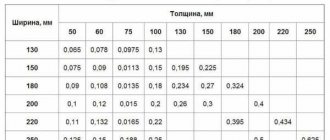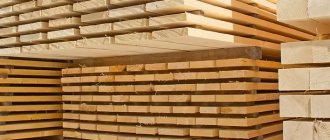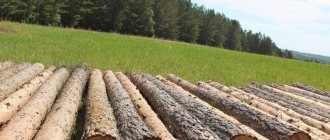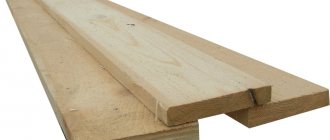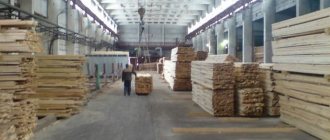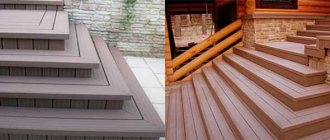Tools and equipment
Trunks and large branches are used for production. All material is divided into groups according to thickness and presence of bark. Often, timber processing enterprises have workshops near the harvesting site, in which machines for the initial processing of wood are installed.
Manual debarking of wood
Wood that has not passed the debarking stage can be used on floors or as ridge beams in the corresponding interior, or as a supporting device during construction.
Industrial debarking of forests
If another option for using the wood is planned, then sawing is carried out, resulting in the following segments:
- unedged and semi-edged (rough material from which the bases of the floor, walls or ceiling are mounted);
- edged (intended for finishing flooring).
The cutting can be carried out by a mobile organization that has all the necessary tools.
Wood cutting map
Rational use of the material is ensured by compliance with the cutting map. This allows you to reduce costs due to waste, the percentage of which the card can significantly reduce. The tools and types of forest processing equipment used depend on the volume, desired quality and size of the finished lumber.
Wood sawing machine
The most commonly used are a circular saw and various machines:
- The circular saw allows you to make precise cuts in various directions. Suitable for both professional and home use, it copes well with above-average round timber diameters;
- chainsaw;
- machines for clean bark removal;
- sawing on a band sawmill makes it possible to process dense logs; it is considered the most popular, since the output is high-quality material and a small amount of waste;
- disk machine: production of double-edged timber and unedged boards;
- a frame sawmill does not require a foundation, the technology using it allows you to install the equipment in close proximity to the felling site;
- the fine gauge is processed by universal machines, the output is high-quality building materials even from low-grade logs;
- sawing of round timber at a large woodworking enterprise should be carried out with the largest amount of lumber, differing from the rest in its special quality and precise dimensions. For this purpose, special lines are installed for sawing.
At the sawmill, timber and edged boards are obtained by cutting logs up to 7 m long and 15-80 cm in diameter along the longitudinal line. A circular saw has one or more disks and processes wood of different diameters according to their number.
Sawmill
If you need to process a small amount of wood at home, you can use a regular chainsaw.
Cutting wood
Before choosing a tool, you need to decide on the type of cut, focusing on the annual rings of the log. There are several types:
- radial (along the radius);
- tangential (the cut is parallel to one radius and touches the annual rings);
- the fibers are located parallel to the cutting being performed.
Among the cutting methods, the one that is most suitable for a particular case is selected:
- Waddle. Sawing wood in this way is carried out for deciduous trees with a small trunk thickness, and is considered the simplest processing. Output: unedged elements and slabs.
- If you have another forest processing machine, then it is possible to cut up to 65% of the material to produce edged boards of equal width. First, the double-edged timber and boards on the sides are cut, and then a certain amount of edged lumber is obtained from the timber.
- More specific methods are sector and segment sawing. The number of elements in the first method varies from 4 to 8, and depends on the thickness of the trunk. After dividing, elements are cut from each sector along a tangential or radial line. The second method begins with the timber coming out of the central part, and boards are cut from the side segments in a tangential direction.
- For individual cutting of wood, the circular method is suitable. It is based on turning the log along the longitudinal line by 90° after each sawn board. This allows you to monitor the quality of the wood and promptly remove affected areas of the trunk.
Manual work: using a chainsaw
For home cutting of several trunks, it is not advisable to purchase a tool whose cost is several times higher than the price of finished products.
If you have the necessary skill, then it is more efficient and cheaper to do all the necessary work with a conventional chainsaw or chain equipment powered by electricity.
Of course, such work requires much more physical effort and time, but the cost of the issue is significantly reduced.
Working on a garden plot requires pruning fruit trees, and it also becomes possible to additionally produce material for outbuildings without resorting to the services of specialists, so any thrifty owner will prefer to buy a chainsaw.
Most often, coniferous wood is harvested for the home, and this tool does an excellent job of cutting it. Thanks to straight trunks, it is easier to mark cutting lines, which increases the speed of work.
Professionals, by the way, most often use a chainsaw, since it is more powerful than an electric one and can be used anywhere, regardless of whether there are power sources at the cutting or cutting site.
Wood cutting options
To use a chainsaw to cut logs, you will need a device such as a saw attachment, as well as cutting guides and base-trunk fasteners. The frame-shaped attachment is attached to the tool so that it remains possible to adjust the distance between the chain and the frame itself.
This is done to make it possible to produce finished lumber of different thicknesses. For the role of a guide, you can take either a profile of the required length, or a flat wooden plank with sufficient rigidity. A special chain is selected for the tool, designed to cut the trunk lengthwise.
Its difference from the others lies in the teeth sharpened at a certain angle.
Before you start work, you need to not only prepare all the necessary tools. Regardless of whether a woodworking machine or a manual device is intended for processing the trunk, the first thing you need to do is familiarize yourself with the cutting map. This is done in order to minimize the percentage of waste and increase the yield of useful products.
The first thing you need to worry about when cutting longitudinally is the uniform density of the finished boards. To do this, a competent sawyer directs the tool from the east side of the log to the west, or in the opposite direction. This is explained by the higher density of round timber in its northern part than in the southern part.
Types of sawing
Next, use a chainsaw to remove the slab from both sides so as to obtain a double-edged beam. It, in turn, is sawed in accordance with the cutting pattern chosen at the beginning of the work. The solution is an unedged board. If there is a certain percentage of defects in the trunk, then a circular cut is possible with the trunk turning at a right angle or 180°.
Quantity of finished material, cutting price
The yield of useful material from coniferous and deciduous trees differs in percentage. The following indicators are typical for lumber obtained from coniferous trees:
- provided that the operation is carried out by a professional and a circular sawmill is used, the percentage of finished wood will be the highest (80-85%);
- the edged material produced by the machines averages 55-70%;
- When used with a chainsaw, an unedged board leaves up to 30% waste.
The figures are given without taking into account the finished culled timber, the amount of which can reach 30%. However, such material is used for products that allow certain defects.
Finished wood products after sawing
Deciduous round timber produces 60% of the finished unedged timber and about 40% of the edged timber. This is explained by the initial curvature of the round timber. It is possible to increase the amount of products obtained: this will require forest processing machines of various types. A certain kind of device can increase the amount of lumber by 10-20%.
For one cube of lumber you will need about 10 cubes of deciduous round timber. The cost of installing additional equipment will be recouped by the cost of the finished timber. Special lines provide greater volume, but their use is only advisable over a large area.
The average price of sawing wood at a regular sawmill will be approximately 150-180 rubles per cubic meter of boards.
How to optimize the yield of lumber from roundwood
When sawing wood, it is important to immediately calculate what the consumption will be, as this will affect the cost of lumber. The yield of finished products may vary. It all depends on the quality of the wood used and whether measures are taken to optimize cutting.
There are special measures to increase work efficiency, make the output better, and the quality of sawing higher. Before sawing, you need to pre-calculate everything.
This is not as difficult as it might seem, but the consumption of round timber will be optimal and profitable to obtain an excellent result.
Options for cutting round timber.
How to increase cutting efficiency
In order for the yield of lumber to be significant, it is necessary to use special measures to increase the efficiency of the process:
- The calculation should be carried out only when using special programs; manually it will have low results, and the percentage of defects will be high.
- The round timber must first be sorted so that processing is carried out correctly.
- For cutting it is necessary to use high quality equipment. Otherwise, the amount of waste will be large, and the quality of the resulting lumber will be low.
- It is best to cut wide lumber first; narrow lumber takes longer to process.
- It is not recommended to take long logs.
- Before work, you should set up the equipment.
The yield of finished lumber may vary. It must be remembered that at the first stage boards are obtained, then they are sorted. As a result, the percentage decreases even more; for example, for deciduous trees it can be only 10-20%.
How to optimize cutting
Sequence and dimensions of cutting round timber.
To increase the yield of lumber, the cutting process must be optimized. This applies primarily to those workpieces that have significant curvature. To cut a crooked round timber, you need to perform a number of steps:
- First, only suitable wood is selected for work. If the remaining logs have rot, sprouts, or cracks at the ends, then it is necessary to trim off some areas.
- If a rotten core is discovered during work, you can carefully remove it, and then saw the remaining part. This will allow you to avoid large losses and obtain boards with a length of 1 m or more with the required quality.
- It is recommended to use logs with a larger diameter so that the yield percentage is higher. The coefficient can be 1.48-2.1, but it all depends on the diameter, quality of the round timber, sorting, and equipment. For frame shops this coefficient will be 1.48-1.6, and for lines with milling equipment - 1.6 for large timber. With a round log diameter of 12 cm or more, the coefficient can exceed 2.1.
Related article: Painted walls in the interior: turquoise, blue, gray
Volume of waste after sawing
In order for the finished board to come out with a high percentage, everything must be prepared correctly, the work must be carried out only in accordance with the technology. Roundwood of coniferous and deciduous species produces different yields.
In the latter case, the volume is smaller, even if special additional equipment is used. Needles are considered more convenient for sawing, since their trunk is straight and the log has a larger diameter.
Coniferous forest is not so susceptible to rotting, so there is less waste. For hardwood, 2 cutting technologies are usually used:
Types of lumber from roundwood.
- using a band sawmill on Z75, Z63;
- into collapse, when a half-beam is cut out in the core of the material and passed through a multi-saw machine.
The volume of a band sawmill is 40-50%. When using technology for collapse, the yield is different, it can be increased up to 70%, but the costs of such work are higher.
If you cut round timber, the length of which is 3 m, you can see that the percentage of scrap is quite large, and the remaining material requires processing. This applies to the bulk with boards 22x105(110, 115)x3000 mm. There are many options for such a marriage.
For example, it could be a wormhole, which is no longer suitable for most jobs.
After sorting, the volume of hardwood material, which belongs to grade 0-2, will be only 20-30% of the amount obtained after sawing.
This means that of the total mass of harvested round timber, the yield of normal boards will be only 10-20%. The remaining materials are mainly used for firewood.
For coniferous round timber, the yield will be different, but attention must be paid to what average values of the resulting volume are observed.
Lumber output
In order for the yield of lumber to be optimal, numerous conditions must be taken into account. To calculate correctly, you can consider the example of round timber yield. The data was obtained from the real experience of specialists and from the performance of sawmills. This makes it possible to compare percentages and calculate optimal average numbers.
Related article: How to hang a cornice on drywall: recommendations
For conifers, the following solution is possible:
The name of the board in the sawn log.
- For unedged boards and other unedged materials during sawing, the yield will be 70%. This is the amount of material obtained during processing, the amount of waste will be equal to 30%.
- For edged material, when using sawmills of 63, 65, 75, there will be a lower yield of lumber, only around 45%. For band sawmills, the yield is usually up to 55-60% of the finished material. If you use means to increase efficiency, you can reach 70%, although this requires extensive experience.
- From a circular sawmill you can get lumber in the amount of 70-75%, although using methods to increase efficiency it may well be 80-75%. But work experience is required.
According to GOST 8486-86, for grade 0-3, the yield percentage, not taking into account sorting, is approximately 70%.
Another 30% can be left for rejecting the finished material. The rejected material is not thrown away; it is used for the manufacture of other types of lumber, which allow for the presence of certain defects.
For deciduous roundwood, a different yield percentage is observed:
- For unedged material - 60%.
- For edged wood - up to 35-40%, since the curvature of the original deciduous wood is usually large.
The output can be increased; additional equipment is used for this. This could be a special multi-sawing machine, an edge trimming machine, or a slab machine. In this case, the yield of lumber will increase by about 20%.
The given percentage is given based on data on obtaining boards of grade 0-4. When sorting grades 0-1, the percentage of lumber obtained is 10%.
To get a cube of finished edged hardwood material, you need to cut 10 cubes of the original round wood.
The yield of lumber from roundwood may vary. It all depends on the original type of wood used by the sawmill. Special measures to increase efficiency allow you to get a higher percentage than is possible, but for this you must have some experience.
Related article: Floor on loggia and balcony made of plywood
You may also like
Step-by-step instruction
Before sawing a log into boards with a chainsaw, you should properly prepare the raw materials in order to obtain a minimum amount of waste at the end. In this section I’ll tell you how the process worked out for me:
- First of all, I built a guide from two boards and connected them with screws (it turned out to be a 90-degree angle) and placed it on the racks, fastened the entire structure with self-tapping screws and fixed it to the tree. Then I attached a plastic strip to the place where the saw blade was attached using double-sided tape. It will ensure sliding during cutting.
- I also attached a metal corner to the center of the board and directly to the log so that the guide board was installed evenly and held more firmly. Then I started the chainsaw and cut the bark along the plank. Then he moved the guide to the other side and so on in a circle so that the log turned out to be a square.
- The next step, I made markings on the log, approximately how thick the boards should be (I made markings every six centimeters);
- Then I moved the guide to a horizontal position so that the top of the board was at the level of the markings I had made. Then I installed the saw on the guide with the part where the plastic sliding panel was attached and sawed off the first board with a uniform movement.
- Then I secured the guide below to the next mark and did the sawing in the same way.
Source youtube.com
As a result, I was able to prepare six boards of the same size. The amount of starting material depends on its thickness and the size of the log itself.
Advice! The construction of special nozzles with guides is necessary in cases where it is necessary to perform horizontal separation. Working using a cross-cut option does not require special equipment added to the chainsaw.
This video shows two ways to cut logs into boards with a chainsaw:
Current norms for lumber yield when sawing
When creating a business plan and its subsequent correction, wood processing enterprises always calculate the norms for the yield of lumber when sawing.
When receiving logs, wood processing enterprises always calculate the rate of lumber yield when sawing.
Each country has its own standards, but they are given extremely vaguely, because more accurate characteristics can only be obtained on an individual basis.
Basic information
The volume of finished lumber when sawing is, first of all, determined depending on the technological waste. The latter also depend on many factors. It is very important to take into account the quality of the original lumber, because When sawing logs, the following boards are obtained:
Determining the percentage of lumber yield when sawing timber, in particular round timber
Before sawing round timber, it is necessary to calculate how much volume will be left for further use, and how much material will be spent on processing.
This is important because it affects the final cost of the product. The amount of untrimmed wood you get will depend entirely on what type of wood is used.
At the same time, there are certain measures to increase the yield of lumber after cutting.
What is the yield percentage and its dependence on the diameter of lumber
To understand this, it is necessary to unpack the concept itself. The percentage of lumber yield from roundwood is all the useful wood after sawing.
The rest is waste that is sent for further processing to produce materials such as MDF, fiberboard, chipboard.
It is worth understanding that the volume that will be obtained as a result of cutting wood is calculated for each individual diameter and selected cutting option.
Output table
It is worth understanding the question of why the parameter under consideration depends on the diameter of the forest. Everything here is extremely simple: the fewer cuts there are on the tree, the higher the volume value will be.
Of course, a lot will also depend on the cutting technology and on the sequence in which the cutting was carried out. The correct sequence will be shown in Fig. 2.
It should be understood that small lumber is obtained from small species of wood, and thick boards and beams are made from large timber. It is also worth considering the average diameters with approximate rates of volumetric flow rate:
- 14 – from 45 to 50%;
- 20 – about 52%;
- 25 – on average up to 57%;
- 34 – this is the diameter of lumber, which has the highest volume fraction of 66%;
- if the forest has a diameter of more than 40 cm, then there is a sharp decrease in the materials obtained.
Volume of waste after sawing
In order for the finished product to have a large percentage, everything should be calculated and prepared correctly. And the work process itself must be carried out in full accordance with technology. It is worth taking into account that a round forest of coniferous and deciduous trees will produce different yields of lumber from unedged boards per m3.
In what sequence should round timber be cut?
Note! Coniferous wood is considered the best option due to the fact that they have a straight trunk and a relatively larger diameter. In addition, such wood is not as susceptible to decay, which leads to less waste.
When working with hardwood, 2 processing methods are used:
- Using a 375 or 363 band sawmill.
- In ruins. This technology involves cutting out a half-beam, which is subsequently passed through a multi-saw device.
In this case, the first method allows you to get approximately 40-50% of the output. But the collapse technique differs in a slightly larger volume - up to 70%. The disadvantage of this technology is that its costs are relatively high.
When sawing round lumber 3 m long, you can notice a fairly high level of defects.
Types of chainsaw attachments
With the help of special attachments for gasoline tools, you can produce perfectly smooth and suitable lumber. The design of such equipment will consist of several required parts:
- Guide frame. It will move along the surface that needs sawing strictly parallel.
- A vertical stand, which is designed to fasten and hold the mechanism responsible for the thickness of the finished product.
- The thickness adjustment mechanism itself, which is additionally equipped with handles that regulate the thickness fixing screw.
Source master5.ru
Thanks to the presence of a special regulating mechanism, the result of sawing is the same thickness of products with an ideal surface on all sides. Such material will look like it was produced in a factory. You can use two attachment options for longitudinal sawing logs into boards:
- Professional nozzle. This is a special device that can be purchased at hardware stores. If you have a welding machine, a grinder and a metal profile at hand, then such a design can be easily made at home. It should consist of: guide; additional bushing; vice (for clamping the busbar); nuts on M10 with sufficient hardness; studs m10x250 mm.
- Lightweight nozzle. To produce it, you will only need boards with a length equal to the length of the log, boards in height corresponding to the diameter of the log (they will play the role of racks), self-tapping screws and a screwdriver. This structure is constructed in the form of a corner, which is then attached to racks and fixed to the log. The disadvantage of such a guide is that it constantly needs to be unscrewed and moved to a new cutting location.
Source woodweb.com
- Drum debarker. Another convenient device for sawing logs with a chainsaw. The operating principle is to implement clinometer transmission. It must be secured to the belts on both sides using special pulleys. The performance of the nozzle can be easily adjusted due to the size of the pulleys. When using this type of nozzle, you need to carefully monitor the process so that the surface is uniform.
From personal experience! To make it easier to saw a thick log into boards of the same size, I first sawed it in half.
Yield of sawn timber when sawing round timber: by round timber grade
Hello dear readers and subscribers of the blog, Andrey Noak is in touch with you! Today I will tell you about the yield of lumber when sawing round wood.
Introduction
This parameter is one of the most important indicators in sawmilling. The efficiency of sawing timber depends on this indicator. Many beginners mistakenly believe that the higher this ratio, the better.
In fact, this is not always the case; most specialists know about this, but remain silent. I repeat once again - a high percentage of lumber yield per cubic meter of forest is not always good.
I described in detail why this is so in my book “Organization of sawmilling at a modern enterprise,” but for readers I will lift the veil on this issue at the end of the article.
This is a truly unique e-book, there are definitely no such books in Russia :-)!!! It provides simply colossal information gained from personal experience as a technologist in a large production.
Percentage of round timber
- Calculated using the formula:
- Kout=Vpil/Vbr
- Where K , % is the percentage of lumber yield.
- Vpil , m3 - volume of lumber obtained. Calculated:
Vpil = L*H*B*n1+L*H*B*n2 + …
- where L is the nominal length of the finished lumber;
- H - board thickness;
- B - board width;
- n is the number of boards of each size.
Vbr , m3 - volume of logs from which lumber is obtained. It is determined by the cubature, which can be downloaded from me on this page.
The useful percentage of lumber in production is calculated for each diameter of the forest and for each sawing technology.
I can only give general recommendations, and improvements need to be done in specific places.
Why does the useful percentage depend on the diameter of the wood being cut?
It's very simple, the fewer cuts to obtain wood, the higher the percentage. Of course, it also depends on the useful use, but once again I will say that it is very important how many saws you have to get a board. As a rule, small boards are cut from small wood, and timber or thick boards are cut from large wood.
The company's performance in the production of timber is especially good; its cubic capacity is good, sawing speed is maximum (there are fewer saws after all) and cutting tool consumption is minimal.
Below are the approximate diameters with consumption rates:
- 12 - 16 cm - yield 45 - 50%;
- 18 - 22 - average 52%
- 24 - 26 - about 57%;
- 28 - 40 - this is timber timber and the best results are achieved when obtaining timber - 66%;
- 42 - 60 - in this range there was a decrease in the percentage of boards made from wood. Since this wood is used to produce boards and beams that are not so large, and therefore the number of cuts with a saw becomes many times greater.
These consumption rates are approximate and are valid for the production of such lumber as:
- 25*150*6,0;
- 35*150*6,0;
- 50*150*6,0;
- 180*180*6,0;
- 200*200*6,0.
Based on the type of equipment, these standards can be adopted for band sawmills, sawmill frames and circular saw equipment.
Ways to increase the ratio
There are technological tricks, which I partially talked about in this article. But as they say, repetition is the mother of learning, here are some of them:
- Use of shorter commercial timber;
- Using specialized programs, read about it here. In short, we can say that you need to use the program to find the optimal cost of boards obtained from logs. On the one hand, a high useful yield means a large cubic capacity, and on the other hand, a high indicator means obtaining a larger volume of low-quality wood.
- The use of thinner saw blades due to double-spindle circular saws and the use of stellite tips.
- Use of sorting round timber by diameter, species, defects.
And now in more detail about everything. The shorter the wood, the higher the percentage of lumber obtained. In Europe they know this well and therefore the cutting lines there are calculated at 1.5 - 2 meters. Our sawmill frames can only cut 4-meter logs.
Using programs in production, we calculated our supplies for each season, increasing the amount of low-quality wood during periods of demand (summer, autumn), and increasing the amount of high-quality wood during periods of increased demand for them (winter, part of spring).
I think everything is clear about using a saw blade with the best characteristics. It is also necessary to monitor the quality of the resulting cutting tools. On frame and circular saws, you need to constantly monitor the presence of all solder tips, sharpening angles for each season, and rolling on both types of saws.
Sorting allows logs to be separated by diameter, defects and blemishes. For example, with rot in the core, then the log is sorted and sawed into lumber, instead of being turned into timber. Or vice versa, if the sapwood is rotten, but a beam emerges from the central part, and the log is a timber log, we sort it for sawing into timber. You need to think similarly in terms of blueness and curvature.
Approximate yield by variety
The situation regarding varieties is quite interesting. It turns out that the percentage of yield of high-grade products depends on the following factors:
- The coefficient of production of lumber from round timber. Grade depends not directly, but indirectly. The fact is that after some golden mean, the more planks we get per cubic meter, the higher the amount of low-grade wood with wane;
- The larger the diameter, the higher the likelihood of getting more high-quality boards;
- The presence of wood defects, such as curvature, rot, blueness and others; the fewer there are, the higher the percentage of obtaining a high-quality board;
- The shorter the finished product, the higher the percentage of high-quality boards.
Now let’s estimate, approximately based on the diameter, the percentage of first-class lumber obtained from the total volume of boards produced. To do this, I made everything in the form of a small table.
Table 1 - yield of boards when sawing round timber
| Diameter, cm | Yield of premium grades, % |
| 12 — 16 | first grade yield 40% |
| 18 — 22 | on average 50% |
| 24 — 26 | about 50% |
| 28 — 40 | log timber, during the production of timber you can get indicators of about 70% |
| 42 — 60 | about 60 - 70% |
How does the percentage of lumber production depend on sawing technology?
In addition to diameter, grade, defects (curvature) and length, the percentage of board yield depends on the technology of sawing wood and the type of equipment.
There are two types of sawing technology:
- Individual cutting, the percentage of useful yield approaches 75%;
- Group cutting, depending on other parameters, the useful yield can also reach 70%.
And the equipment for sawing can be the following:
- Band sawmills produce lumber products with minimal wood consumption rates;
- Tire sawmills produce lumber with increased consumption when sawing logs, since the thickness of the chain is much greater than the strips.
- Sawmill frames. It is quite inconvenient to process thin wood using this type of equipment. Therefore, sawing is mainly done from a diameter of 20 - 22 cm;
- Milling canter lines. This type of equipment has both an advantage and a disadvantage over other technologies. He only cuts graded wood;
- Circular saw equipment cuts according to individual cuttings - this is a big plus for the resulting materials, both in quality and quantity.
Wooden circle of fate. How are national dishes made from a piece of wood?
This time, AP journalists went to the south of the republic, to Kulyab, where Lutfullo Kholikov, a master of making wooden utensils, popularly called “the foundations of the kosataros,” demonstrated how a large plate can be made from a piece of wood - tawak for collective food.
Tajik wooden plates – tobacco or tawaki chubi – have a centuries-old history. They can be found in almost every Tajik rural house in the central part and south of the republic. Wooden utensils are used for kurutob, shakarob, fatirshurbo or fatirmask. Tawaki chubin is used for group meals; food is mostly eaten not with spoons, as is customary, but with the hands.
19:00 December 8, 2017
Boxes of master Dilmurod. What is it like to “embroider” with silver?
Master Lutfullo is very young, he is only 26 years old, but he is already quite experienced, his teacher was his father, Master Muhammadi from Korez, famous in the Kulyab district.
Tawak, spoons, mugparas (devices for decorating flatbreads with patterns) and other kitchen utensils, according to Lutfullo, were previously created by his grandfather by hand. “Now you can count such masters on one hand,” he says. “In Soviet times, our fathers learned to make wooden utensils on handicraft machines, and our generation works on special factory machines.”
According to the master, the dishes are mainly made from walnut, plane tree and mulberry, and rarely from willow. Such tawaki can be identified by color: if the dish is white, then it is willow, yellowish – from mulberry, reddish – from plane tree, and if it is dark brown, then it is definitely from hazel.
“The main thing in this matter is the age of the tree,” says usto Lutfullo. — The older the tree, the wider its trunk and it will make good dishes. Only the durability of wood allows the dishes to not crack the first time they are used.”
19:40 November 10, 2017
The sun in the tandoor: how the national oven is made
Each type of wood, however, has its own smell, weight and benefits.
Dishes for every taste
The master uses a chainsaw to deal with a huge trunk in a matter of minutes, dividing it into disks. One such disk with a diameter of approximately 90-100 cm is divided into 4 parts, each piece of which is a future tawak. Then he grinds out one of the pieces with an ax, this is done by hand to make the edges of the dish thin.
According to housewives who constantly use national tawaks, such dishes have several advantages: firstly, they are environmentally friendly. The use of such utensils in the household and kitchen, unlike others, does not affect human health; no harmful substances enter the body. Secondly, it gives a special taste and smell to dishes. Thirdly, it retains heat longer than other dishes, such as porcelain. And fourthly, her exotic beauty. If you have a guest and you have prepared food for him in beautiful patterned wooden plates, then he will most likely be delighted with the uniqueness of your kitchen.
He has a whole stack of such blanks, about 30-40 pieces. The next step is work in the workshop. He inserts the turned material into the machine and begins to twist, grinding off the edges of the dish with a curved knife. Due to the fast operation of the motor, the chips fly in different directions at breakneck speed.
18:46 October 6, 2017
Master of precious metals
The master must ensure that the plate does not turn out too thin or too thick,” he explains, and, inserting a pencil into the center of the dish, he twists it again and again. This is how patterns appear on the plate.
According to Lutfullo’s brother, Abdullo Kholikov, who helps him in his work, per day they can make 10 plates of medium diameter (30 cm) from blanks, but in general, as the brothers explain, everything depends on the wishes of the customer.
They can also make huge tawaki with a diameter of up to 80 centimeters, from which 7-8 people, if not more, can eat at the same time. They also prepare small saucers for children, 10 cm in diameter.
Tips from the master
Wooden plates are usually sold in bazaars, the price of an average size is approximately 50-60 somoni. But our master does not sell his goods on the market; usually traders come to him themselves and buy dishes in bulk.
18:23 October 27, 2017
How to hand weave a carpet in 4 days? Master class from Matparin craftswomen
According to the master’s observations, in recent years the demand for wooden plates has increased greatly, especially in cities where new kurutokhonas are opening. At the same time, Lutfullo regrets that for his work he has to cut down huge perennial trees (30-50 years old), but according to him, these are usually the trees that “get in the way” during the construction of roads or buildings.
Usto Lutfullo says that by engaging in this craft, he is trying to preserve the ancient craft that he inherited from his ancestors. He plans to teach his sons how to make wooden utensils when they grow up.
According to archaeological excavations, already in the 8th century BC, people used wooden utensils, and even decorative carvings on dishes were noticed. National wooden plates create coziness, comfort, and fill the room with a certain warmth and kindness. It is safe to say that a good housewife will find wooden utensils useful in the kitchen and will not hurt in the household.
The master also shares with us tips on how to properly handle wooden utensils.
“The new tawak must be covered with cellophane so that there is no access to air, because the wood still has moisture and if it is left in the open air, it will immediately crack. Then the dishes need to be wiped with fat or oil for two or three days; some people fill it with salt for a while, which also serves as oppression, and only then use it. In such dishes, food will be tastier and more aromatic, which is why our people love to eat in it,” says Usto Lutfullo.
You can read about other interesting crafts in Tajikistan and watch videos by following this link
